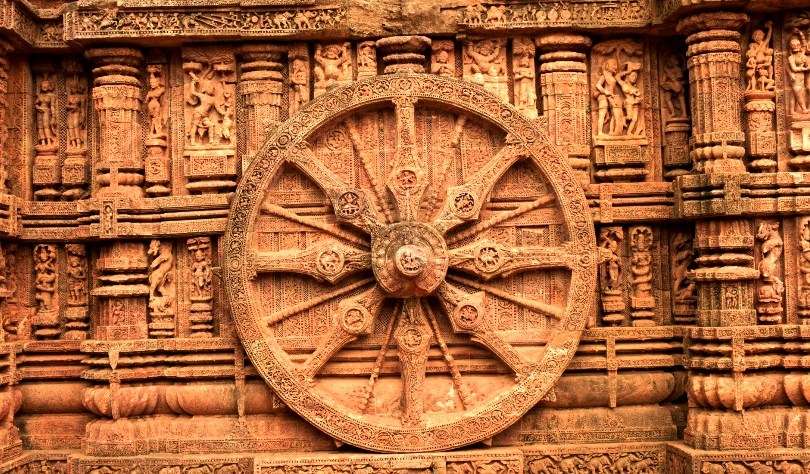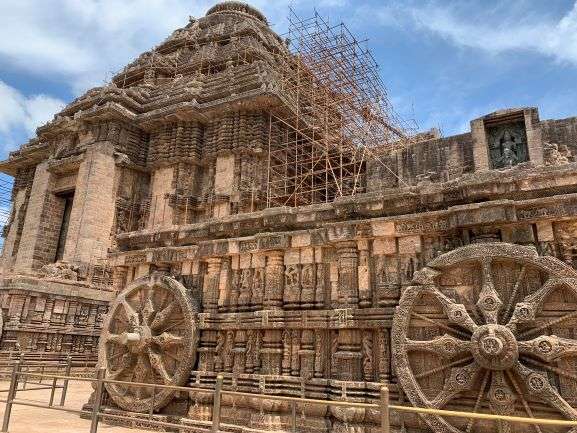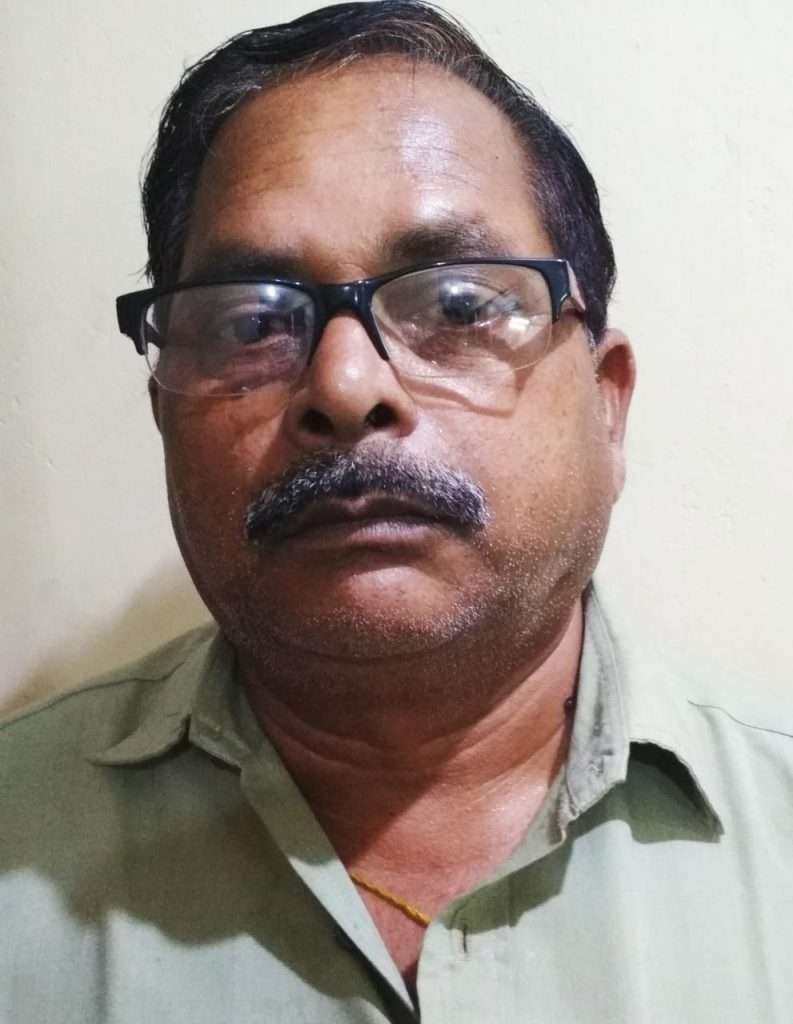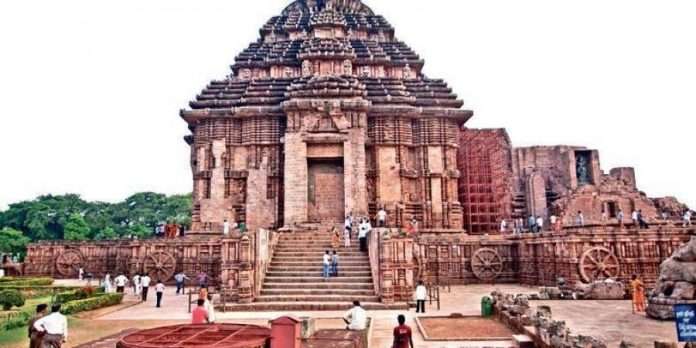Konark Sun temple is a 13th century temple at Konark on the east coast of Orissa dedicated to the worship of sun God. The temple is now in ruin. The temple was constructed by Narasingha Deva-1 of the eastern Ganga dynasty in about 1250 AD. The main temple has been damaged and not in existence. Only the mukhasala of the temple is now standing on the spot. And in front of mukhasala the remains of natya mandapa is still there. Konark temple is a marvel of Odisha style of architecture.
The cause of the destruction of the Konark temple is not clear and is a matter of debate for historians, archeologists,s and public laymen. Much of the temple architecture was damaged by the invaders down the centuries especially Muslim armies between the fifteenth and seventeenth centuries. The temple was being called a black pagoda by the European sailors in the seventeenth century because it looked like a great tower that appeared black.

In the British time after the department of an archeological survey of India was established by Lord Curzon, the temple was repaired and now it has been declared a World Heritage site in 1984 by UNESCO. Konark sun temple is an attraction for visitors both from home and abroad. On the Tila Saptami day of the month of Magha every year, the Hindu pilgrims congregate on the seashore of Chandrabhaga near Konark to make a holy dip in the sea.
The sun worship is widely prevalent in India. There is legend that Samba the son of Lord Sri Krishna started worship in this Arkakshetra to recover from a dreaded disease which was cursed by his father Lord Sri Krishna himself. There are many sun temples in India in different places like Lord Martanda temple in Jammu. Martanda means sun God. In some other places also like in Mulastana (the modern Multan), Modhera in Gujarat, in Assam also sun temples are found. But it is a strange matter that all the sun temples in India are in ruin condition now.
What may be the reason? The destruction might have been caused by the ravages of nature. But why the other God temples are in ruin? There is a spiritual reason for it. As the sun God is very very big in size and covers a maximum portion of the solar system, he can not be confined to a small place like a temple. The Garbha Griha(sanctum sanctorum) is a very small place to accommodate such a large God. So, the sun temples everywhere in India have been destroyed by the wish of the sun god. Probably the sun God desires an open place for His worship.
Another attraction of the Konark sun temple is its erotic structures of the body of the temple. The visitors are much fascinated and astonished by these exciting sculptures. But it is a misconception. Actually, the four Purusarthas – Dharma, Artha, Kama, Moksha have been equally depictedon the body of the temple. But the visitors very often ignore the other three Purusarthas. The Kama Purusartha is the most prominent for them. Rightly it is said – the beauty lies in the eyes of the beholders.
The Konark sun temple has attracted many poets also. The Oriya poet Nilakhanta Das has written a kavya on this temple titled as ‘Konarke’. This kavya is an emotional rendering of sun temple about its history, construction and destruction. The poet expresses his sorrow at the destruction of the temple, which was so marvelous and pride of Orissa. He has written –
“Kaha Ramachandi Kahago
Sakhi Eka Ta Tuhi
Kemante Asichhi Ee Bhume
Kala Taranga Bahi
Chumbaka Ki Ethi
Otaru Thila Jahaja Mana.”
(Oh Goddess Ramachandi, you are witness of all which have happened on this land. How the bad time came to this temple. Was there a magnet on the top of the temple, which was attracting the ships on the sea? And when it was taken out from the temple, the temple became imbalanced and fell on the ground.)

As the temple was dedicated to the sun God, it was constructed in the form of a chariot and with seven horses who were pulling the chariot. The temple was constructed with stones. King Narasingha Deva employed Siva Samanta Rai Mahapatra (SibeiSantara as supervisor architect). It is marvel that how such big stones were taken to the top of the temple and the temple was constructed. At that time the engineering was not so developed. It is imagined that by filling sands gradually such huge stones were uplifted and placed in their structure.
It is said that the temple was constructed in sixteen years by twelve hundred architects. When the temple was completed the Sikhara of the temple could not be placed properly even by all the twelve hundred architects. Many times, they tried, but failed. So, the king was annoyed and ordered that by tomorrow morning the Sikhara should have been completed otherwise they would be beheaded. So, a twelve-year boy Dharmapada, the son of the main architect SibeiSantara completed the Sikhara in the night and after that from the top of the temple he jumped into the sea water. As a result, he died instantly. So that he sacrificed for the lives of all the twelve hundred architects.
From this description it is learnt that at that time the temple was standing exactly on the sea shore. So Dharmapada could jump into the sea form the top of the temple. But now the temple is standing at 3 km from the sea.
This great temple collapsed sometime in the late sixteenth century or after. According to the experts the original temple must have stood to a height of 225 feet. Such a beautiful temple was destroyed by evil weather or by an evil person is a matter of regret. Such an architecture cannot be constructed in our modern times. Because such ingenuity is absent in our modern minds. Anyhow a replica of this sun temple should be constructed for posterity. Otherwise, such a beautiful thing will go into oblivion.
(The views expressed are the writer’s own.)

Radhakanta Seth is an Income tax officer in Sambalpur. He is a freelance writer and his articles have been published in some Oriya dailies like Sambad, Samaj, Dharitri, and English dailies like The Telegraph and in a sociological journal ‘Folklore’ published from Kolkata.
He can be reached at [email protected]

